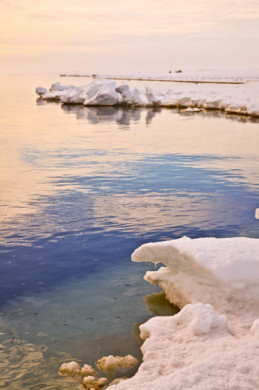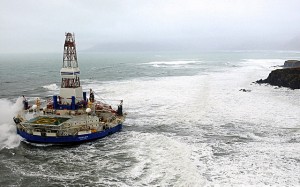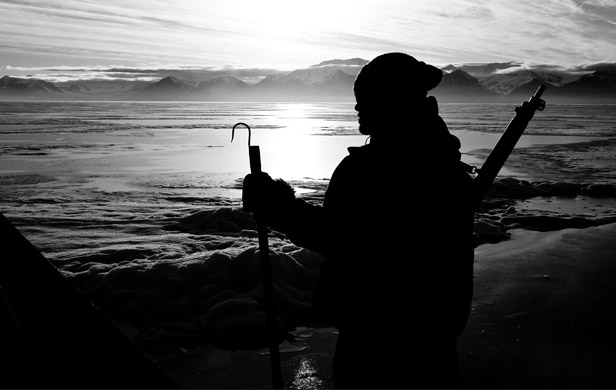By David Lavallee
Documentary filmmaker David Lavallee recently journeyed to Canada’s Arctic for his forthcoming film, To the Ends of the Earth, which drills deep into the modern age of extreme energy. Plans to open the arctic to seismic testing are a source of growing controversy.
“Nanook”, our guide Bryan Simonee says while scanning the ice floe edge. Nanook, nanook. I’ve heard that word before – my brain struggles with recall of its meaning. I know about five words in Inuktituk and this is the 6th. Nanook…nanook of the north? Doesn’t it mean polar bear?
Indeed it does, and this particular one is at about 50 metres and closing, drawn to our camp by the smell of boiled seal soup. A large male. “Uh, is your rifle nearby?” I ask nervously. Simonee’s rifle is already in his capable hands, and he seems mildly annoyed at this curious 1200 pound animal, a highly skilled and highly adapted predator. He walks towards it and growls something in Inuktituk. It pauses, then begins marching sideways instead.
Not satisfied with its slow retreat, Simonee aims his vintage Lee Enfield above its head and fires a warning shot. It stops, looks at us with mild concern and then saunters off with a look that says, “ok FINE then, have it your way.” I breathe a sigh of relief and Bryan says to me:
[quote]Yes, you see, the danger is real.
[/quote]
Extreme energy coming to Canadian Arctic?

The danger to the Arctic is indeed real, and that is why I’m here. I’m on location shooting my upcoming feature documentary, “To the Ends of the Earth”. This film focuses on our geographical and geological ends of the earth exploration for the last remaining reserves of oil and gas and the economic/environmental consequences of this new energy age. My goal with this film is to begin a conversation I believe we sorely need: what it means to live in an age in which we witness the rise of extreme energy.
Extreme energy is in its infancy in the Arctic, but there is no question that without sustained opposition and visionary thinking to create alternatives, world oil demand will force a final offensive into the most pristine and brutal environment known to humankind – those nether regions of the cryosphere (i.e. ice covered) areas north of the Arctic Circle.
No country for vegetarians
The impending gold rush starts with seismic testing, and that is what has the residents of Clyde River and Pond Inlet concerned. The subsistence hunting culture on Baffin Island dates back 4,000 years, and the advent of modern technologies, such as snowmobiles and high powered rifles, has facilitated that culture, not changed it.
Hunting is more than sport here, it is a way of life and food source for many in an area where a bag of grapes or red peppers could cost up to $20. Vegetarianism is not a realistic option up here, a place where the nearest tree is about 2,000 km away and vegetable gardens have perhaps a one-month out of twelve chance of producing anything, with constant risk of freezing. Tomatoes here? Good luck. “Vegetarian is an-other word for ‘bad hunter’,” said one of there folks we encountered. Free range organic meat is on the menu for sure though – we all enjoy a natvik Bryan shoots and butchers right there on the ice. Now I know what seal tastes like – the texture of beef but the taste of sushi.
[signoff3]
It is this subsistence hunting culture that is clashing today with big oil interests who would drill in the Arctic. In the National Energy Board hearings it became clear there would be opposition from locals due to the impacts of seismic on the food chain, or what they would call “country food”.
It all starts with seismic
The so-called regulator held hearings into seismic applications by various companies, who would do the seismic work then sell the data to oil companies. But locals are concerned about the process of consultation and the lack of information from the proponent about seismic and the potential for massive oil spills in such a fragile ecosystem. Indeed they should be – British Columbians and Canadians who watched for several years the NEB process regarding the Northern Gateway saw intense opposition. They poured their hearts out in presentation after presentation with some 96% opposed, only to watch the Harper government approve the pipeline anyways. Perhaps the people of Pond Inlet and Clyde River already know what we southerners have come to learn: that NEB processes to ‘regulate’ oil companies are like kindergarten – everyone passes.
In an interview in Clyde Rive, Jerry Natanine told us:
[quote]Seismic testing is the chief concern at the moment. The impacts will go all the way up and down the food chain.[/quote]
Indeed, there is evidence to support this. An article published in Elsevier, a science journal, questions the impact of seismic testing on narwhals in particular. Narwhal are a food source for the Inuit and are an animal highly dependent on its echolocation capabilities to find its way to the breathing holes in the ice it needs to avoid drowning. The underwater world, especially in winter, is a chaotic, dark and jumbled mess of ice blocks – if ever there was an animal that depended on its sense of hearing it is the narwhal.
As an example, Jerry tells us about a narwhal entrapment north of Pond Inlet in 2008. Locals had rushed to the aid of the beleaguered creatures, all 500 of which were using the same breathing hole to avoid drowning. As they pulled the dead creatures out and attempted to punch new holes in the ice for them they noticed a curious thing:
[quote]They had just migrated from Greenland, where they had actively been doing seismic testing- we think that’s why there was that blood in their ears.[/quote]
Shell’s early foray into Arctic proves a comedy of errors
After seismic testing is complete, gold rush fever sets in. Oil Speculators and their petroleum geologists pour over the data and buy parcels to establish their claims to black gold, under the ice, at the ends of the earth. With the short season, 3 months at best, it can take up to two years to drill an exploratory well only.

A number of years and a few billion dollars ago, Shell International launched a program to drill in the Arctic, in the Chuckchi Sea off Alaska. Numerous incidents plagued its operations- a fire on one of their ships, an emergency evacuation as several millions tonnes of ice came rushing at an exploratory well which had to pull up stakes, another ship that slipped anchor in Dutch Harbour, AK, and the piece de resistance, the crashing of the Shell Kulluk on the rocks of Kodiak Island, AK, on New Year’s eve 2012.
Since the 2010 Gulf Of Mexico incident, the US Regulator has demanded of those who would drill in the Arctic certain safety precautions such as an Arctic Containment System (ACS) that could theoretically mop up spills in between icebergs. We interviewed Tod Guiton, a local resident of Bellingham (with an apartment overlooking the port) who had been watching Shell fail at this as well – one of the early tests of their containment dome ended up with it being “crushed like a beer can”.
What about growth?
A key focus of society is the environmentally pristine nature of the Arctic and the need to preserve it as such. Indeed this is of critical importance, but is this the only cause for concern? Our interview with Richard Heinberg, author of the book The End of Growth, gave me something else to think about:
[quote]Capital is fleeing big oil right now – it is getting increasingly difficult to fund large scale projects because as we venture into unknown territory (i.e. the Arctic) the chances of success are diminishing. And since there is only so much capital to go around, to spend our last dollars on these foolhardy projects seems like the road to collapse.[/quote]
Whatever dollars go to oil to fund their operations, are societal resources not available to us for transition-ing to clean energy.
Promise of jobs lures some Inuit
Not all the locals of Pond Inlet are convinced that seismic exploration is bad, however. The day after the polar bear incident Simonee and I are discussing the future of Canada’s Arctic and he surprises me by saying: “Seismic could be ok if it’s done right”. Having seen the large pay-cheques of his friends working in the local Mary River iron mine, it is tempting to succumb to the large of black gold as well. But as of 2014, with Shell pulling out of the Arctic, at least temporarily in order to staunch the hemorraghing of investor money, it’s an open question whether it’ll ever happen at all.
As I watch the sun not really set at 2:00 am one morning, casting the world in golden purple rays of unimaginable beauty, I hope it never will.
David Lavallee is a Vancouver-based documentary filmmaker who directed the award-winning White Water, Black Gold and is now filming To the Ends of the Earth.



Unfortunate that the name has been used by the BBC TV series, might that be a disadvantage? I have supported the completion through Indiegogo and look forward to seeing this film. Then I hope the general public can access it and so many other documentaries that are being produced about this time in Canadian history.
Is there any data to show this? The referenced article makes no mention of it.
“As they pulled the dead creatures out and attempted to punch new holes in the ice for them they noticed a curious thing: They had just migrated from Greenland, where they had actively been doing seismic testing- we think that’s why there was that blood in their ears.”